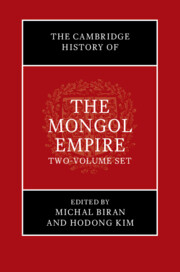Book contents
- The Cambridge History of the Mongol Empire
- The Cambridge History of the Mongol Empire
- Copyright page
- Dedication
- Contents
- Figures in Volume I
- Figures in Volume II
- Maps in Volume I
- Maps in Volume II
- Tables in Volume I
- Contributors to Volume I
- Contributors to Volume II
- Acknowledgments
- Notes on Dates and Transliterations
- Abbreviations
- Volume I
- Introduction
- Volume I Part 1 Political History
- Volume I Part 2 Thematic Histories
- 6 Mongol Imperial Institutions
- 7 Imperial Ideology
- 8 The Military Machine
- 9 Economic Exchange
- 10 Religious Exchange
- 11 Scientific Exchange
- 12 Artistic Exchange
- 13 The Climate and Environment of the Mongol Conquest
- 14 Women and Gender under Mongol Rule
- Volume I Part 3 Views from the Edges
- Volume I Part 4 External Histories
- Epilogue
- Volume II
- Index to Volume I
- Index to Volume II
- References
6 - Mongol Imperial Institutions
from Volume I Part 2 - Thematic Histories
Published online by Cambridge University Press: 01 January 2024
- The Cambridge History of the Mongol Empire
- The Cambridge History of the Mongol Empire
- Copyright page
- Dedication
- Contents
- Figures in Volume I
- Figures in Volume II
- Maps in Volume I
- Maps in Volume II
- Tables in Volume I
- Contributors to Volume I
- Contributors to Volume II
- Acknowledgments
- Notes on Dates and Transliterations
- Abbreviations
- Volume I
- Introduction
- Volume I Part 1 Political History
- Volume I Part 2 Thematic Histories
- 6 Mongol Imperial Institutions
- 7 Imperial Ideology
- 8 The Military Machine
- 9 Economic Exchange
- 10 Religious Exchange
- 11 Scientific Exchange
- 12 Artistic Exchange
- 13 The Climate and Environment of the Mongol Conquest
- 14 Women and Gender under Mongol Rule
- Volume I Part 3 Views from the Edges
- Volume I Part 4 External Histories
- Epilogue
- Volume II
- Index to Volume I
- Index to Volume II
- References
Summary
This chapter deals with various political, military, and social institutions that were rooted in the Mongols’ steppe tradition, which pre-dated the founding of their world empire. These institutions, which were continuously developed and modified by regional Chinggisid polities, also impacted post-Mongol empires. The chapter explains the formation and the transformation of the key concept of ulus (people, nation), and analyzes the composition and the maintenance of the ordo (mobile court) which was the geopolitical center of the ulus. It also analyzes military institutions, including decimal units, e.g., mingghan (chiliarchy) and tümen (myriarchy); the royal guards (keshig) and the garrisons (tamma); the main civil officials, such as the darughachi (governor) and jarghuchi (judge); and the postal system (jam). These topics only partially represent the wide variety of Mongol imperial institutions that still await extensive research, yet they offer a glimpse of how the Mongols ruled the world.
- Type
- Chapter
- Information
- The Cambridge History of the Mongol Empire , pp. 399 - 443Publisher: Cambridge University PressPrint publication year: 2023

